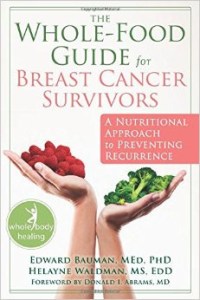Cancer Survivorship: A Nutritionist’s Perspective
March 24, 2016 | Author: Helayne Waldman, MS, EdD
What happens when cancer treatments end? Many folks describe the feeling as one of abandonment, of falling off a cliff into what’s supposed to be a new “normal.” But for many, life is anything but normal. There’s the uncertainty of what’s next, the fear of recurrence, and the very physical discomforts that can follow treatment such as neuropathy or lymphedema.
In 2005 the Institutes of Medicine (IOM) decided to address this gap that patients- turned- survivors now faced. In a report they called From Cancer Patient to Cancer Survivor: Lost in Transition, it was recommended that all cancer survivors be given a plan to help them carry on with their lives healthfully after treatment. This is a big step forward for both patients and practitioners. Still, many challenges remain. The good news is that many of these challenges can be met successfully by starting with the basics of healthy eating.
Cancer Treatment and Nutrient Depletion
That’s because our nutritional reserves can be seriously depleted by cancer treatments. For example, did you know that undergoing major surgery with a general anesthetic will create a drain on your magnesium reserves? That chemotherapy depletes trillions of healthy gut bacteria that help keep our immune system healthy, make nutrients for us, detoxify carcinogens and perform a host of other indispensable functions? And that steroids such as Decadron, given with chemo to help alleviate side effects, can cause depletion of Vitamins A, D, C, B6, B12, Folate and the minerals zinc, selenium, magnesium and chromium? No wonder so many survivors complain of feeling “not quite right.”
How to Start a Nutrient Restoration Plan
Eating organic, nutrient dense food is the perfect way to start your nutrient restoration plan. Aim for 40-50% of your body weight in grams of lean, clean protein daily. That could include animal protein from high-quality eggs, wild fish and grass-fed animals (the latter needs to be seen more as a side dish, not as a main dish), as well as plant-based proteins like nuts, beans and legumes, plus 6-12 portions of vegetables and fruits a day. If this sounds overwhelming, don’t worry. In terms of nutritional power, a cup of green tea is easily the equivalent of a serving of vegetables. And one delicious smoothie can contain four, six, eight or more fruit and/or vegetable servings in one tall glass.
Don’t Forget the Healthy Fats
Fats are as important as the other macronutrient groups of protein and carbohydrates. That’s why nature provides them for us and why we nutritionists don’t want you to skimp on them. Just be sure that you eat the fats that nature truly made – not the ones that come from a factory assembly line. Nuts and avocados are terrific sources of healthy fats, and of course. we all know about the nourishing qualities of olives and olive oil from the legendary Mediterranean diet. And recent research has validated what Polynesians have known for centuries: coconut oil is a superb oil for cooking and baking.
Start here and you’ll be on your way to what I call “nutrient restoration.” In subsequent posts, we can get much more specific about more ways to do this.
Join the conversation: Ask Holistic Cancer Coach Facebook Group
